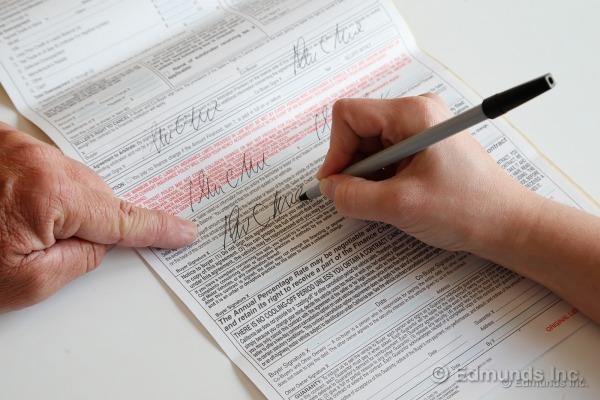
The moment of truth has arrived. The new car sales contract is in front of you. The finance manager is extending the pen so you can sign on the dotted line.
You might have been told that you should read contracts before you sign them. But this document is long and packed with fine print. What should you look at? And are there any clauses in it that will bite you later?
Take heart. The contract isn't quite as complicated as it looks. In fact, in most states, it's actually a standard form that is the same at all dealerships. So it's not so much the language in the document that is your concern. Instead, it is the numbers in the little boxes that you need to review carefully.
Your preparation for this crucial car buying step should begin before you are sitting in the sales office being offered a pen by the finance manager. I know because I've learned it the hard way, since I've purchased more than 100 cars for the Edmunds test fleet. Here's what I do.
Run the Numbers
I begin by gathering prices and key numbers, which I'll describe in more detail later. Then, I plug the numbers into this monthly loan payment calculator, which adds related taxes and most fees. I now know the amount of the check Edmunds will have to write. Dealers call this the "out-the-door" price.
Before getting the car, I sometimes ask for the actual contract to be faxed to me, or e-mailed to me as a PDF. However, an easier way to accomplish the same thing is just to ask for a copy of the "worksheet," which lists all the figures that will go into the final contract. These are the agreed-upon numbers that I will review when I sign for the car.
But what if you're financing the car? Or you have a trade-in? Or you're leasing? Those contracts are just a bit more complicated, as you'll see.
Cash Sales Contract
If you purchase a car for cash, only a few simple numbers make up that final amount:
In addition to these figures, the contract might also contain a customer cash rebate. The dealer lists this as a down payment and it reduces the purchase price of the car. Additionally, a buyer may use a trade-in to lower the price of the new car.
The calculator we just discussed will pull in the current market value of the car — Edmunds' True Market Value TMV®) price — and most of the other figures listed above based on the ZIP code you provide. The only figure the calculator doesn't track is the documentation fee, which is usually $50-$200.
New-Car Finance Contract
Taking out a loan for a new car from the dealership complicates the contract a bit by adding more figures for you to check. (Actually, auto manufacturers make the loans but dealers handle the paperwork.) In addition to the figures above, you need to know:
Again, plug these numbers into the calculator to verify your monthly payment and the related figures.
New-Car Lease Contract
With a leased car, it's all about getting the right monthly payment. You can estimate the monthly payment by using our leasing calculator. You will, however, need to know the residual value of the car: what it will be worth after three years. You can either call the finance manager at the dealership for this information or, to get a rough estimate, put in half the value of the car, since most automobiles lose 50 percent of their value after three years.
Here are the elements that make up the key monthly lease figure:
If you control these four figures, you control your cost, which is your monthly payment. However, a lease contract can involve a trade-in or a cash rebate (both of which reduce the capitalized cost of the car). Also, there could be a lease termination fee in the contract: typically about $300.
For more information, see Edmunds' Quick Guide to Leasing or the more comprehensive "10 Steps to Leasing a New Car."
Contract Stumbling Blocks
You can see that if you know the numbers ahead of time and if the dealer's contract matches your numbers, then it's a deal you can sign with confidence. But what if the numbers have changed or the total is different?
Review all the boxes in the contract and see if the dealer has added to or changed any of them. In some cases, the difference could be only a few dollars, attributable to a small local fee such as tire disposal on your trade-in. But in other cases you might find a new, more substantial fee added to the contract. This can be a real problem or even a deal breaker.
Some dealers will insert questionable fees in a contract to increase profits. They write these fees into different boxes, giving them official-sounding names like "market adjustment" or acronyms like "S&H." These sudden extras can be stressful and awkward, particularly if you only discover them when you're reviewing the contract. However, if you ask for an "out-the-door" price early on, you will smoke out these extras and deal with them well before the contract phase.
Don't Fear the Dotted Line
As you can see, running the numbers ahead of time ensures that there won't be any surprises at signing. It is then a simple matter of verifying the figures in the contract and double-checking the length of the loan or lease. Then you can confidently write that check.